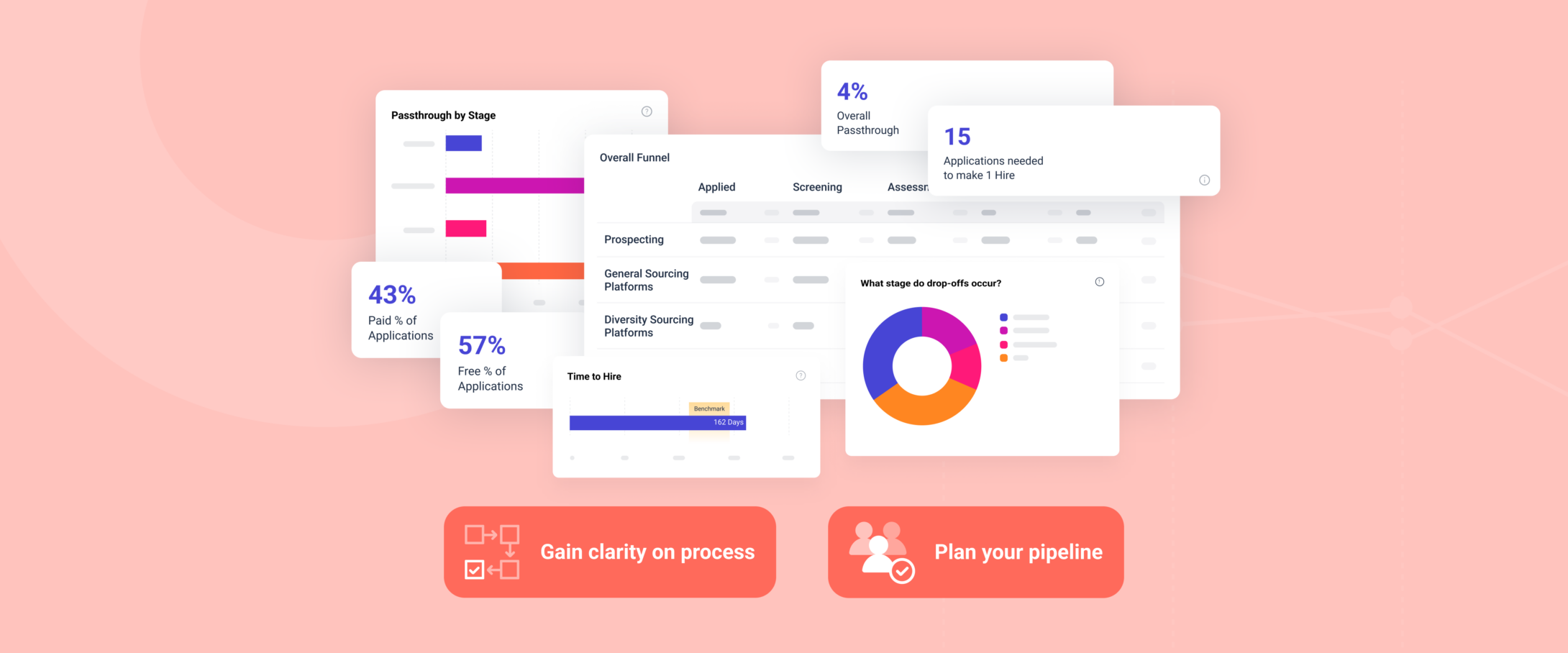Lots of things can derail recruiting efficiency and candidate experience, negatively impacting your hiring outcomes. While some are just the realities of recruiting, others are the result of inefficiencies in your recruiting process.
Process missteps like long applications, time-consuming assessment tests or projects, and disorganized interviews can result in candidates withdrawing from the hiring process, a long time to fill or, as our data shows, no hire at all (i.e., a no-hire requisition).
The problem: An obscured view of your candidate pipeline
While candidate experience seems subjective, it’s not. Clear, standardized data on every phase of your hiring process can help you identify and fix issues for a better overall candidate experience and, consequently, greater hiring success.
There’s a few metrics you can use to assess and address the experience candidates have. Two key metrics, in particular – pass-through rate and drop-off rate – can go a long way in helping you create a more efficient recruiting process.
Yet messy recruiting data obscures the view into your candidate pipeline (e.g., unclear applicant sourcing data). If talent teams can’t make sense of the data or identify problems without a ton of manual effort, they can’t improve the process in a timely manner.
Applicant tracking systems (ATSs) enable a lot of customization. Each department can assign its own set of hiring stages to their requisitions. For example, marketing may have five stages while engineering has six. Also, hiring teams can tailor stages for individual jobs. So junior jobs may get four stages while senior jobs get six. Or sales executives may have to complete role-playing exercises while software engineers complete coding challenges.
To get clear reports with this level of inconsistency means doing a lot of manual data analysis and cleanup. That takes time (assuming you even have someone who can do it) and makes quick decisions and process improvements all but impossible.
Without clear data, it’s nearly impossible to gauge your company’s pass-through and drop-off rates at scale or benchmark across departments or externally. Even within departments, inconsistency among jobs obscures the view into how candidates are moving (or not) through the hiring process.
The solution: Datapeople Insights Pass-through and Drop-off Reports
Our Pass-through Report maps all of your hiring stages (no matter the number or how they vary across your organization) to HR best practices – in real time. This means no more cleaning up or organizing raw data before you can even start analyzing it. Instead, you can effortlessly identify the rates in which candidates are passing through from one stage to the next and instantly make adjustments for greater recruiting efficiency and hiring outcomes.
Similarly, our Drop-off Report organizes all of your hiring stages to help you uncover stages where candidates are voluntarily dropping out of the hiring process. This enables you to take meaningful action and adjust for a better candidate experience and recruiting efficiency, resulting in a stronger employer brand and lower time to fill and time to hire.
Questions you can confidently answer with the Pass-through and Drop-off Reports:
- What are our pass-through and drop-off rates by stage?
- Based on our historical pass-through rates, how many applicants do we need to make a hire?
- Do pass-through or drop-off rates vary by department? Geography? Seniority level?
- At what stage do a majority of candidates drop out?
- How does our drop-off rate compare to other companies?
…and more.
How those insights help your recruiting efficiency:
- Plan intelligently: Build a data-backed hiring strategy with accurate forecasts of the number of applicants needed to make a hire (based on your historical pass-through rates).
- Achieve hiring goals, faster: By identifying stages where pass-through and drop-off rates are too high or too low and optimizing accordingly, you’ll reduce time to fill and increase offer acceptance rates.
- For example: If you suspect your assessment stage has an issue (e.g., a project takes too long or is unreasonably challenging), look for a high drop-off rate or low pass-through rate from that stage to the next. Same thing with every other stage of the hiring process. Once you identify an issue, you can fix it.
- Enhance your employer brand: Provide a consistently positive candidate experience across your entire organization. So no matter the outcome, candidates retain a positive impression of your brand.
Datapeople Insights
With Datapeople Insights, we take the leg work out of recruiting data analysis so you can spend your time doing meaningful work, not manual work. Request a demo to get one step closer to more fair, efficient, and successful hiring outcomes.
